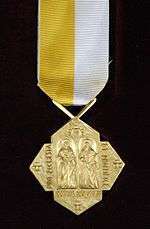Pro Ecclesia et Pontifice
The cross Pro Ecclesia et Pontifice ("For Church and Pope" in Latin) is a decoration of the Holy See. It is currently conferred for distinguished service to the Catholic Church by lay people and clergy.
| Pro Ecclesia et Pontifice | |
|---|---|
 Obverse of the current medal | |
| Awarded by | |
| Country | Holy See |
| Eligibility | Clergy and laity |
| Awarded for | Rewarding those who in a general way deserve well of the pope on account of services done for the Church and its head |
| Status | Currently awarded |
| Statistics | |
| Established | 17 July 1888 |
| Precedence | |
| Next (higher) | Order of St. Sylvester |
| Next (lower) | Benemerenti medal |
Current ribbon Previous ribbon | |
History
The medal was established by Leo XIII on July 17, 1888, to commemorate his golden sacerdotal jubilee and was originally bestowed on those men and women who had aided and promoted the jubilee, and by other means assisted in making the jubilee and the Vatican Exposition successful.[1]
In 1898, it became a permanent papal distinction.[2] Pius X reduced the classes to a single one in 1908.[2]
Until 1993, it was the highest honour that could be obtained by women.[3]
Appearance
1888 version of Leo XIII
The cross was initially only cast in gold and silver.[2] A bronze version was added later.[2] On the medal is a cross made octangular by fleurs-de-lis fixed in the angles of the cross. The arms of the cross narrow towards the center, with slightly indented ends, approaching the form of the patonce cross. In the center of the cross is a small medal with the image of Leo XIII. The words "Leo XIII P. M. Anno X" (tenth year of his pontificate) circle the image. In the center of the reverse side are the papal emblems. The motto Pro Ecclesia et Pontifice is stamped in the circle surrounding the emblems.
On the obverse side of the medal, the branches of the cross are comets, which, with the fleurs-de-lis, form the coat of arms of the Pecci family. Stamped on the reverse side are the words "Pridie" (on the left branch), "Kal" (on the top branch), and "Januar" (on the right branch) and the year "1888" (at the foot of the cross). The medal's ribbon is red, with delicate lines of white and yellow on each border.[lower-alpha 1] The cross is worn on the left side of breast.[lower-alpha 2][4]
Current version since Paul VI
The current version was introduced by pope Paul VI and is only awarded in gold. The obverse depicts the Apostles Saint Peter and Saint Paul in the centre of the cross.[5] The inscription Pro Ecclesia (For Church) is stamped on the left arm, Et Pontifice (And Pope) on the right. Three small crosses are situated at the end of the left, bottom and right cross arm. During the pontificat of Paul VI and John Paul II, the top arm of the cross carried the coat of arms of the reigning Pope and his name in Latin on the bottom cross arm. The decoration's ribbon shows is yellow and white: the colors of the Papacy.
The design was modified under Benedict XVI: The individual coat of arms in the top arm of the decoration was replaced by a small cross while the coat of arms of the Holy See replaced the small cross on the bottom arm.[2] The name of the reigning pope no longer appears on the front side.[2]
Gallery
 Version 1888
Version 1888 Version 1978-2005
Version 1978-2005- The medal on the uniform of a papal zouave
 Ellen Ammann with Pro Ecclesia et Pontifice
Ellen Ammann with Pro Ecclesia et Pontifice
Notes
- There is information about the existence of a purple ribbon with white-yellow edges, which should have been used from 1893 to 1908. Such a ribbon most certainly did not exist. It is probably the visual implementation based on the description in the papal letter Quod singulari Dei concessu: "[…] purpurei coloris linea alba flavaque ad utramque oram virgata dependeat […]". The translation of "purpurei coloris" as violet and "linea alba flavaque" as a yellow-white line leads to a different appearance of the ribbon. See:

- The frequently cited article Pontifical Decorations wrongly states that the cross is worn on the right side.
References
- . 1913 – via Wikisource.
- "Ehrenzeichen (auch als ""Ehrenkreuz"" bezeichnet) ""Pro Ecclesia et Pontefice""". www.kuenker.de. Retrieved 2018-04-30.
- Norbert Göckener. "Was sind Päpstliche Ehrentitel?". www.kirche-und-leben.de. Retrieved 2019-07-15.
- "Pro Ecclesia et Pontifice. For the Church and the Pope". antique-photos.com. Retrieved 2019-07-29.
- "Cardinal Brady confers Papal award of the Cross Pro-Ecclesia et Pontifice – 'for the Church and the Pontiff' – to Mr Joe Fallon | Irish Catholic Bishops' Conference". www.catholicbishops.ie. Catholicbishops.ie. Retrieved 2012-05-28.
External links
- Pro Ecclesia et Pontifice For the Church and the Pope In: antique-photos.com.
- Ulrich Nersinger: Päpstliche Ritterorden und Auszeichnungen. In: ZENIT.org, 18. May 2007.
- P.M.J. Rock: Pontifical Decorations In: The Catholic Encyclopedia, New York: Robert Appleton Company, Vol. 4 1908.
- Ehrenzeichen (auch als ""Ehrenkreuz"" bezeichnet) "Pro Ecclesia et Pontefice" in: kuenker.de
